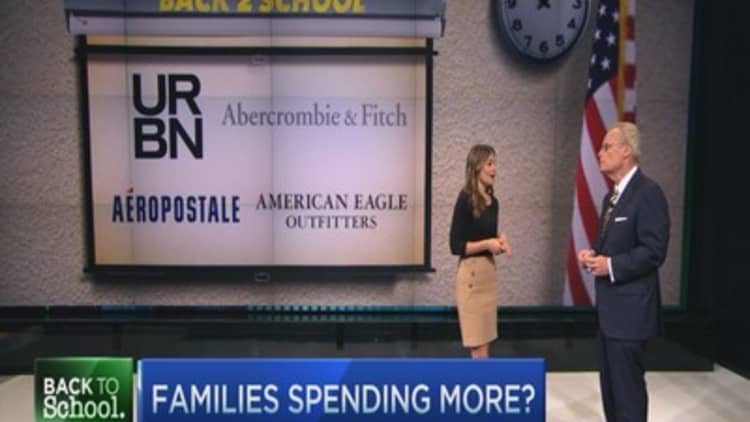
A National Retail Federation poll finds that 29 percent of households with children ages 6 to 17 plan to spend more on back-to-school shopping this year—up from 24 percent in 2014.
That jump is mirrored by an expected increase in spending on college-bound students, with the federation results finding that 30 percent of households with a child or dependent attending college this fall plan to spend more. That's an increase of 7 percentage points.
But there's a catch.
A separate study by America's Research Group found that 58 percent of parents said they would buy only the bare minimum during the traditional back-to-school season, and wait to finish their purchases during the hyper-promotional winter holidays. That's up from 50 percent last year.
"Consumers do not feel the deals on back to school are as hot as they once were," said Britt Beemer, the group's chairman.
Read MoreTeen retailers sweating over this next big test
This game of chicken is one of the biggest challenges facing retailers during the back-to-school selling season, which is second only to the holidays for traffic and sales.
But contrary to Christmas or Hanukkah, which have shopping deadlines, back-to-school buying is much more "nebulous," Wunderlich Securities retail analyst Eric Beder told CNBC last week.
Underlining that point is a separate finding from the National Retail Federation, released last July, which found that nearly one-quarter of families in 2014 started their school shopping at least two months before the first bell rang.
The back-to-school season typically runs from July through September, as summer vacation ends at various times around the country. In Florida, for example, many schools start in August; in New York City, the first day of public school is in September.
"It's a very long time period," Beder said. "The consumer has learned how to play back-to-school to an amazing extent."
Shoppers have particular flexibility when it comes to waiting for discounts on nonessential items, including apparel. As a result, Beemer predicts revenues will be "all over the board" for clothing retailers, depending on who has the most aggressive promotions.
Shoe sales, however, should perform well, as no parent will send their child to school in ill-fitting shoes for three months, he said. Along those lines, supplies required by the teacher or school will also offer less wiggle room for consumers.
Read MoreShipping costs may put retail on the naughty list
There are several external factors that could provide a boon to back-to-school spending. A recent report by Challenger, Gray & Christmas found a 5 percent increase in the number of teens ages 16 to 19 who were employed as of May.
And among the adult set, who fuel the majority of these purchases, consumer confidence has also improved.
"[Back-to-school] could be a proxy for how well mom and dad feel," Beder said.
The bull case, he added, would be that parents haven't spent a lot of money on their kids over the past few years; so now that they're feeling more confident in the economy, they may be more willing to open up their wallets.
For his part, Beemer predicts that back-to-school sales will rise marginally this year, posting around a half-point or one-point increase.
The National Retail Federation will release its consumer spending survey, which forecasts how much consumers will spend on the occasion, in mid-July.


